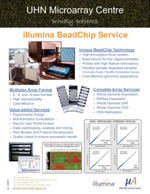home
 services
services  platforms
platforms  illumina: overview & faq
illumina: overview & faq
|
Illumina BeadArray Technology:
|
Highlights of BeadArray technology include:
100% array quality control: The manufacturing process includes a functional validation
sequential hybridisation of every single array element (bead with oligos). This process, called decoding,
allows for the QC of every feature of every array to ensure that each array element is present and functional.
High feature redundancy (15-30x average): Each element is represented in high redundancy
(>20-fold), providing industry-leading data quality and reproducibility, through comparison and averaging
of the many beads of the same type in an experiment.
Inherent flexibility: New bead pools are easily synthesised and deployed, providing rapid
availability of new products and fast turnaround for custom panels.
High feature density: Enables low sample and reagent volumes, multiple hybridisations
can be obtained from a single amplification reaction (>10 µg from 100 ng of total RNA).
Services at a glance:
The BeadChip format, which is used in Illumina's Infinium Genotyping, DASL Gene Expression, and Focused
Arrays applications, is available at the UHNMAC. Our service currently employs gene expression profiling.
DNA methylation will be offered soon.
| Gene Expression | |
|
Sample quality |
DASL method available for FFPE or partially degraded samples* |
| Catalogue array formats | Human (48K); Mouse (25K-45K); Rat (22K); Custom |
*Whenever possible, high quality, non-degraded RNA (RIN >8) is requested. However, for researchers working with partially degraded samples including FFPE samples, we offer the Whole-Genome DASL Assay.
Pricing: Download
![]() (last updated: January 2012)
(last updated: January 2012)
Please note that this pricing is for academic groups. Commercial customers
should contact us for a quote.
Illumina Service Contact:
Julie Tsao
(416) 581-7439
Please note that special paperwork is required for shipping RNA from locations
outside of Canada. For the Customs documentation that you will need, please download this
form ![]() .
Once you send us this information, the UHN Customs Officer will generate the appropriate Customs document
and send it to you via e-mail. This document must be included with the waybill on your package.
.
Once you send us this information, the UHN Customs Officer will generate the appropriate Customs document
and send it to you via e-mail. This document must be included with the waybill on your package.
Quick questions:
 Expand all
Expand all
 Hide all
Hide all
- How much total RNA is required for gene expression and miRNA profiling studies?
100 ng of total RNA is required for gene expression studies. For miRNA profiling, 200 ng of total RNA is required.
- Does the Illumina platform offer 1-colour or 2-colour hybridisations?
For gene expression and miRNA profiling studies, the Illumina platform is a 1-colour system using streptavidin-Cy3 staining. Generally speaking, 1-colour experiments often have less noise and are ideal for long-term experiments where it would be difficult to set-up all control-reference pairs before starting the experiments. 1-colour experiments are often less expensive as fewer arrays and less labelling reagents are required.
- If my total RNA sample appears slightly degraded on the Agilent Bioanalyzer, can I proceed with labelling?
Illumina’s DASL assay (cDNA-mediated annealing, selection, extension, and ligation assay) is designed to generate gene expression profiles from degraded RNAs such as those derived from formalin-fixed, paraffin-embedded (FFPE) tissue samples.
There are three types of DASL assays:- Whole Genome (WG) DASL Assay can be used in conjunction with the HumanRef-8 BeadChip.
- DASL Human Cancer Panel is a pool of selected probe groups that targets 502 genes associated with cancer.
- Custom DASL Assay Panels can be generated for between 512 and 1536 genes. This assay requires the customer to submit a list of candidate genes, transcripts or regions using RefSeq ID, HUGO gene name, or sequence. This method is labour-intensive but worth it if you know the genes that you are interested in profiling and have a relatively large number of samples.
Alternatively, NuGEN offers a the Whole-transcriptome (WT)-Ovation™ FFPE System V2 that enables researchers to perform global gene expression analysis of small and degraded RNA from FFPE samples. The NuGEN protocol takes six hours to complete and is available for an additional fee. The NuGEN amplification system is compatible with the Illumina platform.
- What steps are taken to ensure the least amount of variability?
In microarray experiments, one of the largest sources of variability can be due to the technician performing them. All of our technicians are experienced, highly trained individuals and, whenever possible, the same technician will perform all experiments in a project. Whenever possible, we use arrays from the same print batch, reagents from the same lot, and use the same equipment (hyb oven, scanners, etc.) to reduce array-to-array variability
- If I opt to have data analysis performed, how will the data be analysed?
For most applications, data analysis will be carried out by the UHNMAC Bioinformatics Team using GenomeStudio Data Analysis software (Illumina), in addition to open source software (R package).
- What is the difference between a technical replicate and a biological replicate? And which type is best?
A biological replicate involves isolating RNA independently from replicate sources (multiple patients, multiple biopsies from an individual patient, etc). The purpose of a biological replicate is to control for biological diversity. Biological replicates are often more telling, and for this reason are “better” than technical replicates, however, biological replicates are often more difficult to obtain. A technical replicate would be a multiple labeling or reciprocal labelling of the same RNA sample. This replicate may be useful in some cases (when one slide has poor signal for example) but it has little true statistical value when the experiment works.


